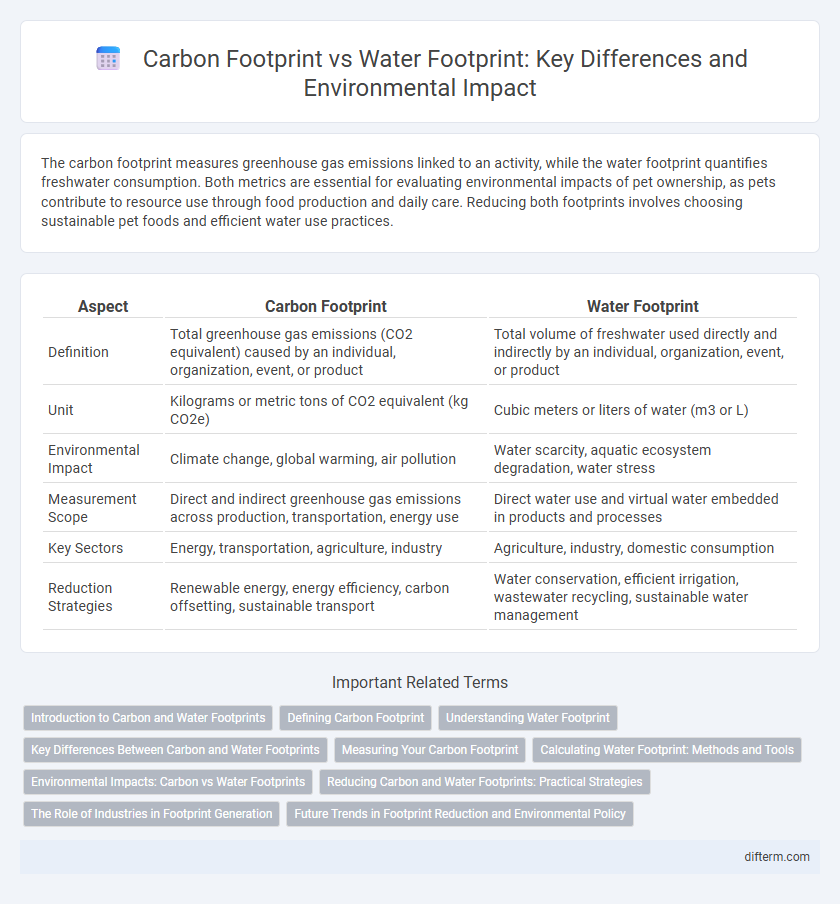The carbon footprint measures greenhouse gas emissions linked to an activity, while the water footprint quantifies freshwater consumption. Both metrics are essential for evaluating environmental impacts of pet ownership, as pets contribute to resource use through food production and daily care. Reducing both footprints involves choosing sustainable pet foods and efficient water use practices.
Table of Comparison
| Aspect | Carbon Footprint | Water Footprint |
|---|---|---|
| Definition | Total greenhouse gas emissions (CO2 equivalent) caused by an individual, organization, event, or product | Total volume of freshwater used directly and indirectly by an individual, organization, event, or product |
| Unit | Kilograms or metric tons of CO2 equivalent (kg CO2e) | Cubic meters or liters of water (m3 or L) |
| Environmental Impact | Climate change, global warming, air pollution | Water scarcity, aquatic ecosystem degradation, water stress |
| Measurement Scope | Direct and indirect greenhouse gas emissions across production, transportation, energy use | Direct water use and virtual water embedded in products and processes |
| Key Sectors | Energy, transportation, agriculture, industry | Agriculture, industry, domestic consumption |
| Reduction Strategies | Renewable energy, energy efficiency, carbon offsetting, sustainable transport | Water conservation, efficient irrigation, wastewater recycling, sustainable water management |
Introduction to Carbon and Water Footprints
Carbon footprint measures the total greenhouse gas emissions caused directly and indirectly by an individual, organization, or product, primarily focusing on carbon dioxide equivalents. Water footprint quantifies the total volume of freshwater used to produce goods and services, encompassing consumption and pollution aspects across the supply chain. Understanding both footprints is essential for assessing environmental impacts, promoting sustainable resource management, and reducing overall ecological strain.
Defining Carbon Footprint
The carbon footprint measures the total greenhouse gas emissions caused directly or indirectly by an individual, organization, event, or product, expressed in carbon dioxide equivalents (CO2e). It includes emissions from activities such as energy consumption, transportation, and manufacturing processes. Understanding carbon footprint is essential for developing strategies to reduce environmental impact and combat climate change.
Understanding Water Footprint
Water footprint measures the total volume of freshwater used to produce goods and services consumed by an individual, community, or business, highlighting the pressure on freshwater resources. Unlike carbon footprint, which quantifies greenhouse gas emissions, water footprint emphasizes water consumption and pollution across agricultural, industrial, and domestic sectors. Understanding water footprint helps identify water-intensive processes and promotes sustainable water management practices to reduce environmental impact.
Key Differences Between Carbon and Water Footprints
Carbon footprints measure the total greenhouse gas emissions caused directly or indirectly by an individual, organization, event, or product, expressed in CO2 equivalents. Water footprints quantify the total volume of freshwater used to produce goods or services, broken down into blue, green, and grey water components. The key difference lies in carbon footprints addressing climate impact through emissions, while water footprints focus on freshwater resource consumption and pollution.
Measuring Your Carbon Footprint
Measuring your carbon footprint involves calculating the total greenhouse gas emissions caused directly or indirectly by your activities, typically expressed in CO2 equivalents. Tools like the Greenhouse Gas Protocol and carbon calculators provide detailed assessments by accounting for energy consumption, transportation, and waste production. Understanding your carbon footprint enables targeted actions to reduce emissions and promote sustainable environmental practices.
Calculating Water Footprint: Methods and Tools
Calculating water footprint involves quantifying direct and indirect water usage through methods like life cycle assessment (LCA) and water footprint network standards. Key tools include the Water Footprint Assessment Tool (WFAT) and Aqueduct Water Risk Atlas, which analyze water consumption, scarcity, and pollution impacts across supply chains. Accurate water footprint measurement supports sustainable water management and reduces environmental impacts linked to production and consumption.
Environmental Impacts: Carbon vs Water Footprints
Carbon footprint measures the total greenhouse gas emissions caused by an individual, organization, or product, directly influencing climate change through global warming potential. Water footprint assesses the volume of freshwater used and contaminated throughout the lifecycle of goods and services, impacting freshwater scarcity and ecosystem health. Both footprints quantify environmental impacts but address distinct resource pressures critical to sustainability strategies.
Reducing Carbon and Water Footprints: Practical Strategies
Reducing carbon and water footprints involves adopting energy-efficient technologies and promoting sustainable water management practices in agriculture and industry. Implementing renewable energy sources like solar and wind power significantly lowers greenhouse gas emissions, while water-saving techniques such as drip irrigation and rainwater harvesting minimize water consumption. Corporate sustainability initiatives that integrate carbon accounting and water footprint analysis drive measurable environmental improvements and resource conservation.
The Role of Industries in Footprint Generation
Industries contribute significantly to both carbon and water footprints, with manufacturing sectors emitting high levels of greenhouse gases and consuming vast quantities of freshwater for production processes. Energy-intensive industries such as steel, cement, and textiles are major sources of carbon emissions, while agriculture and beverage production demand substantial water resources, exacerbating water scarcity issues. Implementing sustainable practices like energy efficiency, wastewater recycling, and alternative raw materials is essential for industries to reduce their environmental footprints and mitigate climate change impacts.
Future Trends in Footprint Reduction and Environmental Policy
Future trends in footprint reduction emphasize integrated strategies targeting both carbon and water footprints through advanced monitoring technologies and circular economy practices. Environmental policies are increasingly incorporating footprint metrics to enforce stricter regulations, incentivize sustainable resource management, and promote transparency in corporate reporting. Emerging frameworks such as the Science Based Targets initiative (SBTi) and water stewardship programs aim to align economic growth with measurable reductions in greenhouse gas emissions and water usage.
carbon footprint vs water footprint Infographic

 difterm.com
difterm.com